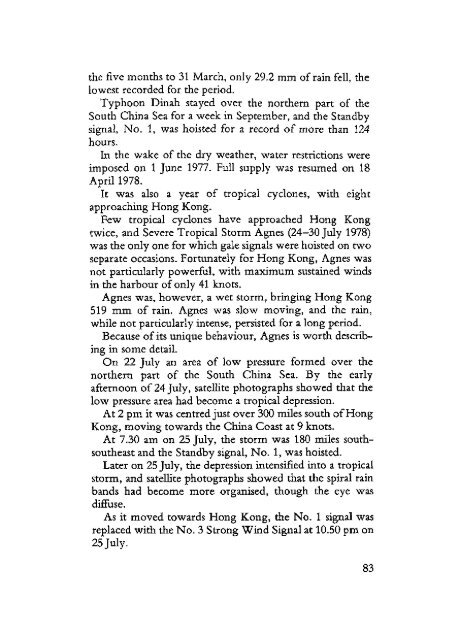Royal - HKU Libraries - The University of Hong Kong
Royal - HKU Libraries - The University of Hong Kong
Royal - HKU Libraries - The University of Hong Kong
Create successful ePaper yourself
Turn your PDF publications into a flip-book with our unique Google optimized e-Paper software.
the five months to 31 March, only 29.2 mm <strong>of</strong> rain fell, thelowest recorded for the period.Typhoon Dinah stayed over the northern part <strong>of</strong> theSouth China Sea for a week in September, and the Standbysignal, No. 1, was hoisted for a record <strong>of</strong> more than 124hours.In the wake <strong>of</strong> the dry weather, water restrictions wereimposed on 1 June 1977. Full supply was resumed on 18April 1978.It was also a year <strong>of</strong> tropical cyclones, with eightapproaching <strong>Hong</strong> <strong>Kong</strong>.Few tropical cyclones have approached <strong>Hong</strong> <strong>Kong</strong>twice, and Severe Tropical Storm Agnes (24-30 July 1978)was the only one for which gale signals were hoisted on twoseparate occasions. Fortunately for <strong>Hong</strong> <strong>Kong</strong>, Agnes wasnot particularly powerful, with maximum sustained windsin the harbour <strong>of</strong> only 41 knots.Agnes was, however, a wet storm, bringing <strong>Hong</strong> <strong>Kong</strong>519 mm <strong>of</strong> rain. Agnes was slow moving, and the rain,while not particularly intense, persisted for a long period.Because <strong>of</strong> its unique behaviour, Agnes is worth describingin some detail.On 22 July an area <strong>of</strong> low pressure formed over thenorthern part <strong>of</strong> the South China Sea. By the earlyafternoon <strong>of</strong> 24 July, satellite photographs showed that thelow pressure area had become a tropical depression.At 2 pm it was centred just over 300 miles south <strong>of</strong> <strong>Hong</strong><strong>Kong</strong>, moving towards the China Coast at 9 knots.At 7.30 am on 25 July, the storm was 180 miles southsoutheastand the Standby signal, No. 1, was hoisted.Later on 25 July, the depression intensified into a tropicalstorm, and satellite photographs showed that the spiral rainbands had become more organised, though the eye wasdiffuse.As it moved towards <strong>Hong</strong> <strong>Kong</strong>, the No. 1 signal wasreplaced with the No. 3 Strong Wind Signal at 10.50 pm on25 July.83
















